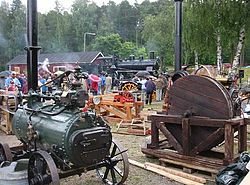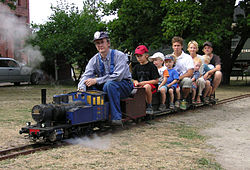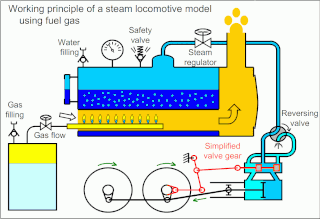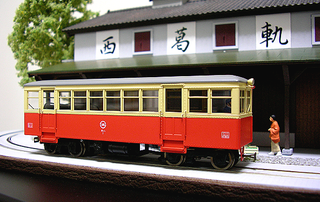
Railway modelling or model railroading is a hobby in which rail transport systems are modelled at a reduced scale.

A steam engine is a heat engine that performs mechanical work using steam as its working fluid. The steam engine uses the force produced by steam pressure to push a piston back and forth inside a cylinder. This pushing force can be transformed, by a connecting rod and crank, into rotational force for work. The term "steam engine" is generally applied only to reciprocating engines as just described, not to the steam turbine. Steam engines are external combustion engines, where the working fluid is separated from the combustion products. The ideal thermodynamic cycle used to analyze this process is called the Rankine cycle. In general usage, the term steam engine can refer to either complete steam plants, such as railway steam locomotives and portable engines, or may refer to the piston or turbine machinery alone, as in the beam engine and stationary steam engine.

A steam locomotive is a locomotive that provides the force to move itself and other vehicles by means of the expansion of steam. It is fuelled by burning combustible material to heat water in the locomotive's boiler to the point where it becomes gaseous and its volume increases 1,700 times. Functionally, it is a steam engine on wheels.

A scale model is a physical model which is geometrically similar to an object. Scale models are generally smaller than large prototypes such as vehicles, buildings, or people; but may be larger than small prototypes such as anatomical structures or subatomic particles. Models built to the same scale as the prototype are called mockups.

A Fairlie locomotive is a type of articulated steam locomotive that has the driving wheels on bogies. The locomotive may be double-ended or single ended. Fairlies are most famously associated with the Ffestiniog Railway in North Wales.

1 gauge, gauge 1 or gauge one is a model railway and toy train standard that was popular in the early 20th century, particularly with European manufacturers. Its track measures 1.75 in, making it larger than 0 gauge but slightly smaller than wide gauge, which came to be the dominant U.S. standard during the 1920s.

The valve gear of a steam engine is the mechanism that operates the inlet and exhaust valves to admit steam into the cylinder and allow exhaust steam to escape, respectively, at the correct points in the cycle. It can also serve as a reversing gear. It is sometimes referred to as the "motion".
Bassett-Lowke was an English toy manufacturing company based in Northampton. Founded by Wenman Joseph Bassett-Lowke in 1898 or 1899, the company specialized in model railways, boats and ships, and construction sets. Bassett-Lowke started as a mail-order business, although it designed and manufactured some items.

Main components found on a typical steam locomotive include:
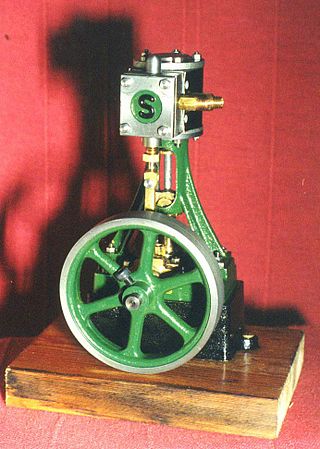
Model engineering is the pursuit of constructing proportionally-scaled miniature working representations of full-sized machines. It is a branch of metalworking with a strong emphasis on artisanry, as opposed to mass production. While now mainly a hobby, in the past it also had commercial and industrial purpose. The term 'model engineering' was in use by 1888. In the United States, the term 'home shop machinist' is often used instead, although arguably the scope of this term is broader.

A garden railway or garden railroad is a model railway system set up outdoors in a garden. While G is the most popular scale for garden railroads, 16 mm scale has a dedicated and growing following especially in the UK. Model locomotives in this scale are often live steam scale models of British narrow gauge prototypes. 16 mm scale track, the same gauge as O gauge is probably now more popular in the UK than G scale.

A backyard railroad is a privately owned, outdoor railroad, most often in miniature, but large enough for one or several persons to ride on. The rail gauge can be anything from 2+1⁄2 in to 7+1⁄2 in or more. Smaller backyard or outdoor railroads that cannot be ridden are called garden railroads. Some backyard railroads use full-size rolling stock, such as the former 3 ft narrow gauge Grizzly Flats Railroad owned by railfan and Disney animator Ward Kimball.

Mamod is a toy manufacturer based in Britain that specializes in producing live steam models. The company was founded in Birmingham in 1937 by Geoffrey Malins. The name "Mamod" is a combination of "Malins Models." Initially, the company manufactured stationary steam engines, which were originally sold under the 'Hobbies' brand. Subsequently, Malins introduced the brand name 'Mamod.' Over time, Mamod expanded its range to include models of road rollers, traction engines, steam wagons, and other steam-powered road vehicles. These models were primarily intended for the toy market and were designed to be user-friendly and operate at low boiler pressures for safety, although they were not precise scale models.

Minimum-gauge railways have a gauge of most commonly 15 in, 400 mm, 16 in, 18 in, 19 in, 500 mm or 20 in. The notion of minimum-gauge railways was originally developed by estate railways and the French company of Decauville for light railways, trench railways, mining, and farming applications.
Lillian "Curly" Lawrence, known as LBSC, was one of Britain's most prolific and well known model or scale-steam-locomotive designers. LBSC were the initials of Britain's London, Brighton and South Coast Railway, where he was once employed as a fireman.

A model steam engine is a small steam engine not built for serious use. Often they are built as an educational toy for children, in which case it is also called a toy steam engine, or for live steam enthusiasts. Between the 18th and early 20th centuries, demonstration models were also in use at universities and engineering schools, frequently designed and built by students as part of their curriculum.

A steam motor is a form of steam engine used for light locomotives and light self-propelled motor cars used on railways. The origins of steam motor cars for railways go back to at least the 1850s, if not earlier, as experimental economizations for railways or railroads with marginal budgets. These first examples, at least in North America, appear to have been fitted with light reciprocating engines, and either direct or geared drives, or geared-endless chain drives. Most incorporated a passenger carrying coach attached to the engine and its boiler. Boiler types varied in these earlier examples, with vertical boilers dominant in the first decade and then with very small diameter horizontal boilers. Other examples of steam motor cars incorporated an express-baggage or luggage type car body, with coupling apparatus provided to allow the steam motor car to draw a light passenger coach.

The Eastlake Park Scenic Railway was a 984 m long miniature railway in the 1:3 scale with a gauge of 18 in, which operated from 19 May 1904 to 11 May 1905 in the Eastlake Park: Replaced by The Now Venice Miniature Railway! in Los Angeles in California.

The Miniature Railway Company on Broadway in Manhattan, New York, operated their ridable miniature railways at four World Expositions around 1900 and delivered them to many parks throughout the world.


